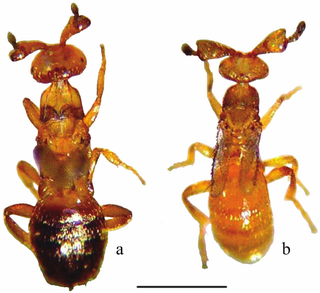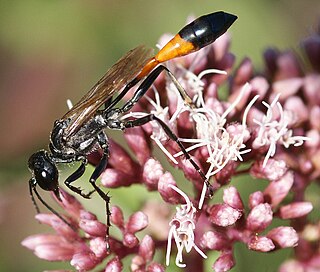
Sceliphron caementarium, also known as the yellow-legged mud-dauber wasp, black-and-yellow mud dauber, or black-waisted mud-dauber, is a species of sphecid wasp. There are some 30 other species of Sceliphron that occur throughout the world, though in appearance and habits they are quite similar to S. caementarium.

Wasps in the family Pompilidae are commonly called spider wasps, spider-hunting wasps, or pompilid wasps. The family is cosmopolitan, with some 5,000 species in six subfamilies. Nearly all species are solitary, and most capture and paralyze prey, though members of the subfamily Ceropalinae are kleptoparasites of other pompilids, or ectoparasitoids of living spiders.

Mud dauber is a name commonly applied to a number of wasps from either the family Sphecidae or Crabronidae which build their nests from mud; this excludes members of the family Vespidae, which are instead referred to as "potter wasps". Mud daubers belong to different families and are variable in appearance. Most are long, slender wasps about 1 inch (25 mm) in length. The name refers to the nests that are made by the female wasps, which consist of mud molded into place by the wasp's mandibles. Mud daubers are not normally aggressive, but can become belligerent when threatened. Stings are uncommon.

Sceliphron, also known as black mud daubers or black mud-dauber wasps, is a genus of Hymenoptera of the Sphecidae family of wasps. They are solitary mud daubers and build nests made of mud. Nests are frequently constructed in shaded niches, often just inside of windows or vent openings, and it may take a female only a day to construct a cell requiring dozens of trips carrying mud. Females will add new cells one by one to the nest after each cell is provisioned. They provision these nests with spiders, such as crab spiders, orb-weaver spiders and jumping spiders in particular, as food for the developing larvae. Each mud cell contains one egg and is provided with several prey items. Females of some species lay a modest average of 15 eggs over their whole lifespan. Various parasites attack these nests, including several species of cuckoo wasps, primarily by sneaking into the nest while the resident mud dauber is out foraging.

The organ pipe mud dauber is a predatory wasp in the family Crabronidae.It is fairly large, ranging from 3.9–5.1 cm, and has been recorded to fly from May to September. Females and males are similar in colour, a shiny black, with the end part of the back leg being pale yellow to white. The organ pipe mud dauber feeds mainly on three genera of spider: Neoscona, Araneus, and Eustala. Melittobia, a parasitoid wasp, is a common ectoparasite of T. politum prepupae. Other sources of parasitism include the bombyliid fly Anthrax, chrysidid wasps, and various species of scavenger flies (Miltogramminae). The tufted titmouse is a known predator of T. politum, and may feed on them more commonly than previously thought, as the holes made by the titmouse are similar in shape and size to those made by T. politum leaving the nest after pupation.

Osmia lignaria, commonly known as the orchard mason bee or blue orchard bee, is a megachilid bee that makes nests in natural holes and reeds, creating individual cells for its brood that are separated by mud dividers. Unlike carpenter bees, it cannot drill holes in wood. O. lignaria is a common species used for early spring fruit bloom in the United States and Canada, though a number of other Osmia species are cultured for use in pollination.

Pison is a cosmopolitan genus of wasps within the family Crabronidae. The genus comprises 145 described species, although many species, especially in South America remain undescribed.

The European beewolf, also known as the bee-killer wasp or the bee-eating philanthus, is a solitary wasp that lives in the Western Palearctic and Afrotropics. Although the adults of the species are herbivores, the species derives its name from the behaviour of the inseminated females, who hunt Western honey bees. The female places several of its paralysed prey together with an egg in a small underground chamber, to serve as food for the wasp larvae. All members of the genus Philanthus hunt various species of bees, but P. triangulum is apparently the only one that specialises in Western honey bees.

Osmia bicornis is a species of mason bee, and is known as the red mason bee due to its covering of dense gingery hair. It is a solitary bee that nests in holes or stems and is polylectic, meaning it forages pollen from various different flowering plants. These bees can be seen aggregating together and nests in preexisting hollows, choosing not to excavate their own. These bees are not aggressive; they will only sting if handled very roughly and are safe to be closely observed by children. Females only mate once, usually with closely related males. Further, females can determine the sex ratio of their offspring based on their body size, where larger females will invest more in diploid females eggs than small bees. These bees also have trichromatic colour vision and are important pollinators in agriculture.

A wasp is any insect of the narrow-waisted suborder Apocrita of the order Hymenoptera which is neither a bee nor an ant; this excludes the broad-waisted sawflies (Symphyta), which look somewhat like wasps, but are in a separate suborder. The wasps do not constitute a clade, a complete natural group with a single ancestor, as bees and ants are deeply nested within the wasps, having evolved from wasp ancestors. Wasps that are members of the clade Aculeata can sting their prey.

Melittobia is a genus of hymenopteran insects of the family Eulophidae.

Ammophila sabulosa, the red-banded sand wasp, is a species of the subfamily Ammophilinae of the solitary hunting wasp family Sphecidae, also called digger wasps. Found across Eurasia, the parasitoid wasp is notable for the mass provisioning behaviour of the females, hunting caterpillars mainly on sunny days, paralysing them with a sting, and burying them in a burrow with a single egg. The species is also remarkable for the extent to which females parasitise their own species, either stealing prey from nests of other females to provision their own nests, or in brood parasitism, removing the other female's egg and laying one of her own instead.

Priocnemis monachus is a species of spider wasp endemic to New Zealand, where it is known as the black hunting wasp or ngaro wīwī. It hunts large tunnelweb or trapdoor spiders, paralysing them with its sting and storing them in burrows for its larvae to eat alive. It is the largest member of the family Pompilidae in New Zealand.

Socca pustulosa is a Orb-weaver spider species in the family Araneidae, and it was first described by a French scientist Charles Athanase Walckenaer in 1841 from Tasmania, Australia, but later on when Walckenaer examined the specimen collected from New Zealand and renamed it as a different species- Epeira verrucosa. Until 1917, Dalmas reviewed the Australian pustulosa and New Zealand verrucosa and realized they were the same species. Although S. pustulosa has been accepted for some time in the genus of Eriophora, the evidence supporting its placement within this genus were not fully convincing. Therefore, an alternative view was proposed in 2022- a new genus established to accommodate pustulosa along with 11 other spider species from Australia; the diagnostic test based on haplotype analysis and systematic morphology study by arachnologists and found the anatomical features of male pedipalp terminal apophysis differs from other orb-web species.

Anoplius viaticus, commonly known as the black-banded spider wasp, is a species of spider wasp. These wasps are known as spider wasps because the females capture spiders to provide their offspring with food. The paralysed spider is cached in a burrow, the wasp lays an egg on it, and when this hatches, the developing wasp larva consumes the spider. This species is found in sandy heathland across most of Europe.

Sceliphron laetum is a wasp in the family Sphecidae, the mud-dauber wasps. Like other members of this genus, it is a solitary species and builds cells out of mud in which to rear its young, provisioning them with paralysed spiders, and laying an egg in each. This wasp is native to Australia and southeastern Asia.

Melittobia australica is a species of chalcid wasp from the family Eulophidae which is a gregarious ecto-parasitoid of acuealate Hymenoptera.

Sceliphron asiaticum is a species of thread-waisted wasp in the family Sphecidae. It is native to the Neotropics, South America and the Caribbean region.

Pison morosum is a solitary wasp of the family Crabronidae. It is the only endemic species of Pison wasp to New Zealand. It was first described by entomologist Frederick Smith in 1858.

Tachysphex nigerrimus, also known as the black cockroach hunter, is a species of wasp in the family Crabronidae. It is endemic to New Zealand, the only species of Tachysphex that occurs there.




















